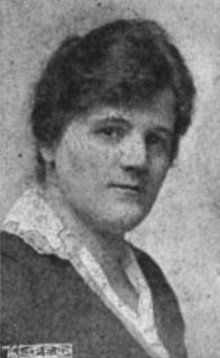Elisabeth Christman
Elisabeth Christman | |
|---|---|
 Elisabeth Christman, from a 1918 publication | |
| Born | September 2, 1881 Germany |
| Died | April 26, 1975 New Delphi, Indiana, US |
| Occupation | Labor organizer |
Elisabeth Christman (September 2, 1881, Germany- April 26, 1975, New Delphi, Indiana) was a trade union organizer.
Christman was born to Barbara Guth Christman and Henry Christman, a laborer and clarinet player for a union band, in Germany 1881. Her family soon moved to Chicago, Illinois after she was born. She attended a German Lutheran school until she was 13, when she left school to become a glove factory worker at the Eisendrath Glove Factory.[1][2]
Union organizing[]
In 1902, after several years of working long hours, she and her co-worker Agnes Nestor lead a successful 10-day strike out. This strike led to the creation of Glove Workers of America Local 1. Christman and 27 other others formed the . She served as the organization's secretary-treasurer from 1913-1931.[1]
Women's Trade Union League[]
In 1903, the Women's Trade Union League was founded, and Christman became a leader at both the Chicago- and national-levels in 1904. She was one of the few working-class women to participate in the day-to-day functioning of the organization until its demise in 1950.[1] She served many positions during her time in the League as:
- Treasurer of Local 1 (1905-1911)
- President of Local 1 (1912-1917)
- Member of the executive board (1910-1929)
- Administrator of the WTUL Training School for Women Organizers (1914-1926)
- Member of WTUL national executive board (1919)
- Secretary-treasurer of National WTUL (1921-1950)
- Delegate for the (1923)[3]
- Editor of WTUL's monthly journal Life and Labor Bulletin (1921-1950)[1]
Christman once said, "Good times or bad,the Labor Movement can not afford to stand still."[1]
In 1915, she led a strike at the , where she gathered over 800 workers to propose a contract. She managed to organize the workers and a contract, though most of the employees spoke little-to-no English and were new to the ideas of trade unionism.[2]
United States government[]
During the First World War, she was appointed by two Republican presidents to commissions in 1921 and 1931 addressing unemployment, although she had been a Democrat her entire life. She served the United States government throughout the Second World War in several advisory positions such as:
- Chief of women field representatives for the National War Labor Board (1917-1918)[4]
- Appointed member of the (1921)
- Appointed member of the (1931)
- Appointed member of the National Recovery Administration (1934), first woman to have this accomplishment, she was appointed by long term friend Mary Anderson[2]
- Appointed member of the (1936)
- Appointed member of the Women's Bureau advisory committee (1940)
- Director of the Women's Bureau of investigation of women's wages in war industries (1942-1943)[1]
In the early 1930s, Christman ran into Eleanor Roosevelt in the streets of Washington, DC and secured a room in the White House for some women in the WTUL to stay in.[5]
Personal life[]
Christman never married, nor did she have any children. Towards the end of her life, she spent much time in a hospital as a patient, though she also organized and led women hospital workers. She died in her niece's home of cerebral arteriosclerosis on April 26, 1975.[1]
See also[]
- Fannia Cohn, leader in the International Ladies' Garment Workers' Union
- Eugene V. Debs, an American labor organizer
- Elizabeth Gurley Flynn, labor leader for the Industrial Workers of the World
- Aileen Hernandez, union organizer and civil rights activist
- Mother Jones, labor organizer in the late 19th and early 20th century
- Matilda Robbins, socialist labor organizer and writer
- "Union Maid", song by Woody Guthrie that speaks on the roles of women in labor unions
- Mary van Kleeck, fellow labor organizer and feminist
References[]
- ^ Jump up to: a b c d e f g "Christman, Elisabeth (1881–1975) | Encyclopedia.com". www.encyclopedia.com. Retrieved 2018-11-07.
- ^ Jump up to: a b c Sicherman, Barbara; Green, Carol Hurd (1980). Notable American Women: The Modern Period : a Biographical Dictionary. Harvard University Press. ISBN 9780674627338.
- ^ Orleck, Annelise (1995). Common Sense & a Little Fire: Women and Working-class Politics in the United States, 1900-1965. Univ of North Carolina Press. ISBN 9780807845110.
- ^ Henry, Alice (1914). The Glove Workers Bulletin.
- ^ O'Farrell, Brigid (1996). Rocking the Boat: Union Women's Voices, 1915-1975. Rutgers University Press. ISBN 9780813522692.
- 1881 births
- 1975 deaths
- Trade unionists from Illinois
- German emigrants to the United Kingdom
- Activists from Chicago
- American women trade unionists